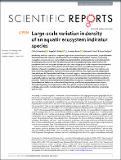Files in this item
Large-scale variation in density of an aquatic ecosystem indicator species
Item metadata
| dc.contributor.author | Sutherland, Chris | |
| dc.contributor.author | Fuller, Angela K. | |
| dc.contributor.author | Royle, J. Andrew | |
| dc.contributor.author | Hare, Matthew P. | |
| dc.contributor.author | Madden, Sean | |
| dc.date.accessioned | 2020-07-21T16:30:05Z | |
| dc.date.available | 2020-07-21T16:30:05Z | |
| dc.date.issued | 2018-06-12 | |
| dc.identifier | 268293368 | |
| dc.identifier | 844bd22c-0324-4c7c-96ab-f26b0ad21ccd | |
| dc.identifier | 85048758345 | |
| dc.identifier | 29895946 | |
| dc.identifier.citation | Sutherland , C , Fuller , A K , Royle , J A , Hare , M P & Madden , S 2018 , ' Large-scale variation in density of an aquatic ecosystem indicator species ' , Scientific Reports , vol. 8 , 8958 . https://doi.org/10.1038/s41598-018-26847-x | en |
| dc.identifier.issn | 2045-2322 | |
| dc.identifier.other | ORCID: /0000-0003-2073-1751/work/75248774 | |
| dc.identifier.uri | https://hdl.handle.net/10023/20299 | |
| dc.description | Funding: This work was supported by the New York State Department of Environmental Conservation and the Hudson River Natural Resource Trustees. | en |
| dc.description.abstract | Monitoring indicator species is a pragmatic approach to natural resource assessments, especially when the link between the indicator species and ecosystem state is well justified. However, conducting ecosystem assessments over representative spatial scales that are insensitive to local heterogeneity is challenging. We examine the link between polychlorinated biphenyl (PCB) contamination and population density of an aquatic habitat specialist over a large spatial scale using non-invasive genetic spatial capture-recapture. Using American mink (Neovison vison), a predatory mammal and an indicator of aquatic ecosystems, we compared estimates of density in two major river systems, one with extremely high levels of PCB contamination (Hudson River), and a hydrologically independent river with lower PCB levels (Mohawk River). Our work supports the hypothesis that mink densities are substantially (1.64-1.67 times) lower in the contaminated river system. We demonstrate the value of coupling the indicator species concept with well-conceived and spatially representative monitoring protocols. PCBs have demonstrable detrimental effects on aquatic ecosystems, including mink, and these effects are likely to be profound and long-lasting, manifesting as population-level impacts. Through integrating non-invasive data collection, genetic analysis, and spatial capture-recapture methods, we present a monitoring framework for generating robust density estimates across large spatial scales. | |
| dc.format.extent | 10 | |
| dc.format.extent | 1367125 | |
| dc.language.iso | eng | |
| dc.relation.ispartof | Scientific Reports | en |
| dc.subject | GE Environmental Sciences | en |
| dc.subject | QA Mathematics | en |
| dc.subject | QH301 Biology | en |
| dc.subject | DAS | en |
| dc.subject.lcc | GE | en |
| dc.subject.lcc | QA | en |
| dc.subject.lcc | QH301 | en |
| dc.title | Large-scale variation in density of an aquatic ecosystem indicator species | en |
| dc.type | Journal article | en |
| dc.contributor.institution | University of St Andrews. Statistics | en |
| dc.contributor.institution | University of St Andrews. Centre for Research into Ecological & Environmental Modelling | en |
| dc.identifier.doi | https://doi.org/10.1038/s41598-018-26847-x | |
| dc.description.status | Peer reviewed | en |
This item appears in the following Collection(s)
Items in the St Andrews Research Repository are protected by copyright, with all rights reserved, unless otherwise indicated.

